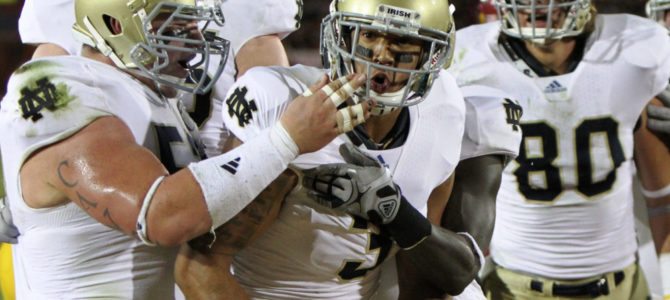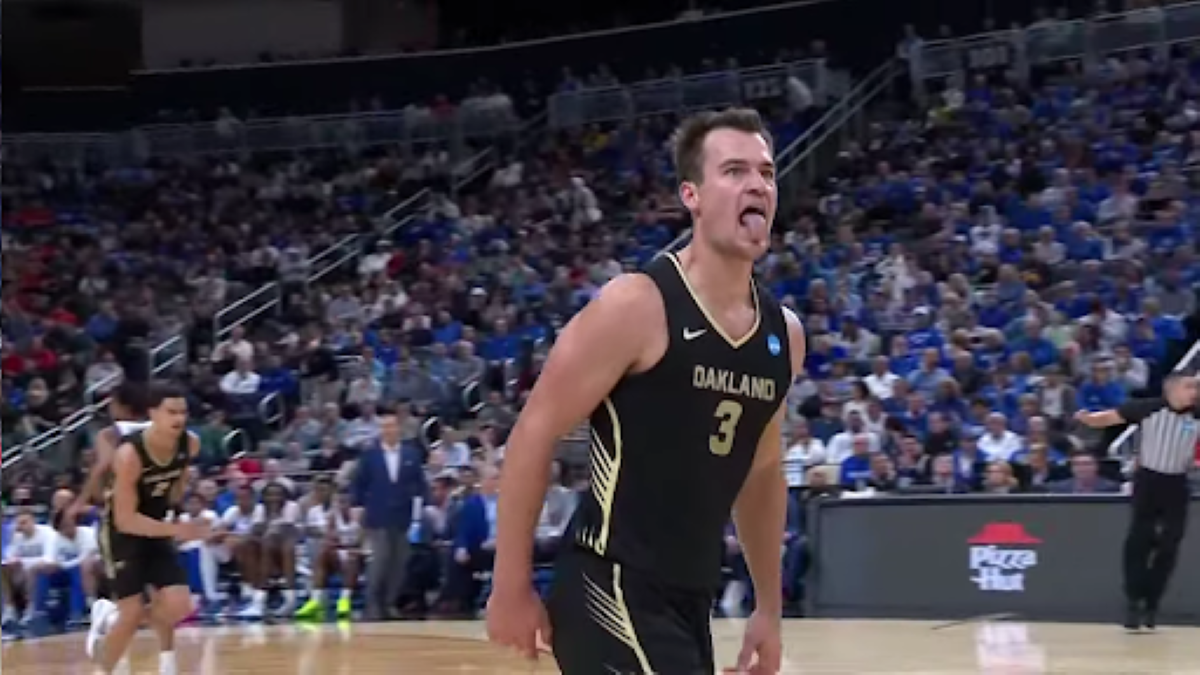
One sympathizes with Max Kellerman. He emerged as a leading voice on ESPN just as it was pioneering a new model of programming defined by placing two or more people in a room and having them compete to offer the most insipid commentary possible, preferably on issues only tangentially related to the action on the field.
Competition is stiff on the network that continues to employ both Stephen A. Smith and Tony Kornheiser. Worse yet for Kellerman, he had to fill the shoes of Skip Bayless, whose contributions to the annals of asininity in broadcasting made him a legend. It would be difficult for Kellerman to live up to such expectations, but by God he is going to try.
Kellerman reached for the stars earlier this month on an episode of First Take in which he attempted to draw an equivalence between the Native American mascots used by franchises across various sports and the “Fighting Irish” moniker used by the University of Notre Dame. He condemned the latter as an offensive ethnic stereotype that should be changed to avoid offending Irish-Americans.
Kellerman is not the first person to make this case, but he is one of the most prominent, and his hot take on the subject encapsulates its emptiness. As an Irish-American and Notre Dame alumnus I am happy to explain why calling for the leprechaun’s head, far from being a blow for justice, is an utterly futile and self-serving exercise in which one attempts to establish progressive bona fides by tearing down an actual symbol of progress.
Although Notre Dame adopted the “Fighting Irish” officially in the 1920s, its ties to the University go back further. During the Civil War, the Union Army’s Irish Brigade was nicknamed the Fighting Irish. Its chaplain was one Rev. William Corby, who gained renown for his ministry to the brigade at Gettysburg. The same Rev. Corby eventually became the third president of Notre Dame. Statues and buildings on campus, as well as multiple South Bend businesses, bear his name in recognition of both his pivotal role in the community and the comfort and guidance he provided to his Irish compatriots on one of the bloodiest days in American history.
While Corby was the first connection between Notre Dame and its future mascot, “Fighting Irish” remained an insult for decades. At the turn of the twentieth century, when Notre Dame football teams became national contenders, press and opposing fans began to use it and other choice epithets — Dirty Irish, Papists, etc. — to dismiss and denigrate them. According to legend, an 1890s matchup at Northwestern featured a crowd chanting, “Kill the Fighting Irish!”
Bigotry against the Irish, Polish and other Catholic immigrants who populated Notre Dame’s student body motivated many other schools, including Michigan under Fielding Yost, to blackball them from competition. As Notre Dame continued to win amidst these obstacles, they adopted the Fighting Irish moniker themselves as a badge of honor indicating an indomitable determination to win and a willingness to fight no matter the circumstances. In 1927, University President Rev. Matthew Walsh made things official, stating, “I sincerely hope that we may always be worthy of the ideal embodied in the term ‘Fighting Irish.’”
That ideal became central to Notre Dame’s mission and ethos. It still defines the football program, as anyone who witnessed the miraculous ending of this year’s Citrus Bowl can attest. But it has taken on a broader meaning at the school at large, which has continued to embrace it even as it has grown into a powerful and diverse institution. Notre Dame’s Keough-Naughton Institute is the largest center for Irish studies in the United States, boasting internationally renowned programs in Irish language, history and culture and intensive student immersion programs in Ireland. More broadly, I personally saw the determination and resolve embodied in the term “Fighting Irish” at work everywhere in the school’s culture.
The number of initiatives on Notre Dame’s campus that illustrate this are too many to list, so I will stick with the one closest to both my own heart and the Fighting Irish iconography. This week marks the start of Notre Dame’s 88th Bengal Bouts boxing tournament, in which I was blessed to participate for three years. Since 1931, the student-run club has put on a tournament to raise funds for Holy Cross missions in Bangladesh.
Preceded by months of training and preparation, each year it raises over $100,000 to support those missions’ schools and medical facilities. We would fight, sweat and bleed with the determination embodied in that leprechaun not only to win, but also to support those missions in their own fight — against poverty, disease, and spiritual brokenness in a fallen world. That is what being one of the Fighting Irish meant and continues to mean for me. You could take away my Irish ancestry and it would mean the same thing, and it is this universality that has made the Fighting Irish an icon that people of all colors and creeds wear proudly.
It is not enough to say Kellerman has his history wrong. It is not enough to point out that the origin of the Fighting Irish makes it more or less the opposite of, say, the Washington Redskins, who adopted an ethnic slur as their name for no seeming purpose and with no positive social consequences. That name has for years been under fire from Indian tribes across the country, and has been decisively rejected rather than embraced. It was not adopted as a badge of honor but as a marketing ploy. While changing it would be unlikely to result in significant progress on more pressing issues such as the high rate of poverty in Native American communities, it is undoubtedly a reasonable proposition on its own merits.
The same goes for Chief Wahoo, the longtime cartoon mascot of the Cleveland Indians, whose removal from Indians uniforms sparked Kellerman’s commentary. While this distinction is crucial, it is not the most important lesson we can learn from this controversy. In equating the Fighting Irish with these far more objectionable cases, Kellerman has inadvertently provided an object lesson in the poisonous and destructive aspects of modern liberalism’s emphasis on policing the expression and use of culture.
There are few things our progressives condemn with such ferocity as cultural appropriation. Their critique is grounded in the assumption that the scars of oppression and marginalization are incurable and permanent — that they will always divide us. Rather than allowing all cultures to come together and contribute to one unique, evolving, overarching American identity, we are meant to vigorously protect the purity and separateness of each one.
To do otherwise is not only disrespectful, but actively harmful. Participating in or identifying with cultures outside one’s own lane is condemned, justly or unjustly as — to use the preferred nomenclature — problematic. Progressives are not always wrong in doing this. In many cases cultural appropriation is, for lack of a better term, inappropriate. The Redskins and Chief Wahoo are examples of this. But the Fighting Irish pose a profound challenge to this dogma.
“Fighting Irish” was once indeed an ethnic slur, highlighting stereotypes of Irish belligerence, drunkenness, and self-destructive behavior. During the potato famine of the 1840s, such stereotypes made it easier to justify English indifference to the suffering of the Irish people. They buttressed the proposition that such a pugnacious people could not possibly govern themselves.
The name later became connected with conflict, and in some places it still is. When I visited Northern Ireland as part of a Keough-Naughton study abroad program, we were advised to avoid using or displaying the name due to its association with the IRA. When the Fighting Irish nickname was applied to Notre Dame, the university and the broader Irish-American community could have chosen to bury it. Instead, they redeemed it, and in the process of doing so they did not claim sole ownership of it or push outsiders away, but invited the rest of the country to join in it, making it something that Americans of all races and ethnicities could admire and be a part of.
Notre Dame’s symbols are not the only ones that are meant to stand for a set of values that transcend any ethnic origins or historical baggage. This country itself is built upon a similar premise — dedicated, as Lincoln put it, to a proposition, not to one race. Our national symbols are monuments to ideals: individual liberty, equality of opportunity, and the right to govern one’s own conscience in thought, word and deed. They proclaim the truth that these freedoms produce a nation far stronger and more prosperous than one bound by force and fear.
Identity politics, whether they come from the left or right, reject this claim, positing that they have only created freedom and opportunity for the privileged and the strong, and that the only way for others to progress is for them to preserve communities and cultures apart. Against these politics of division, the Fighting Irish provide a stinging rebuke and a symbol of hope.
If the leprechaun and shamrock can unite people of all backgrounds in common purpose, why not the eagle and the Stars and Stripes? If a community devastated by persecution, famine, and religious conflict can find triumph and redemption, why not one riven by racism, political divisions and socioeconomic strife? For an ideology holding that such things are impossible in America as it is presently constituted, this line of questioning is problematic indeed.









